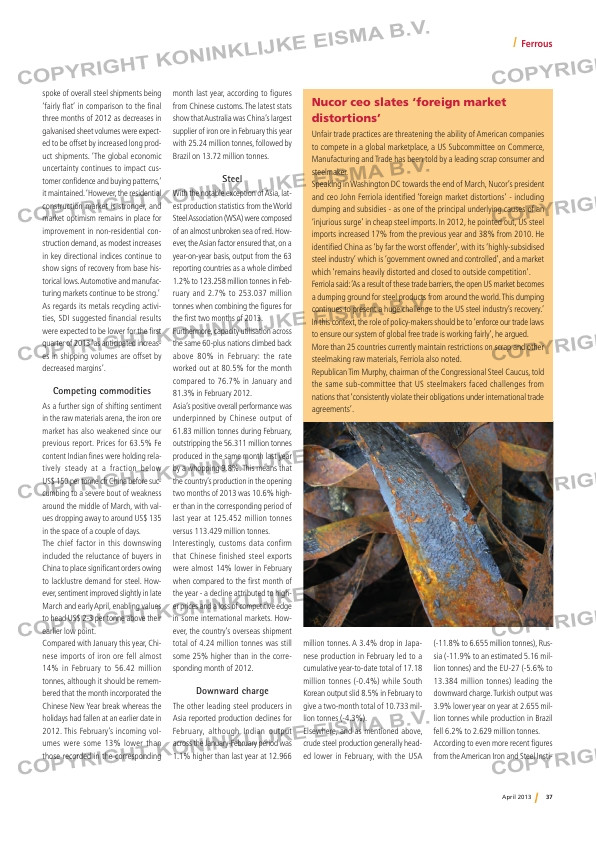Page 37 from: April 2013

37April 2013
Ferrous
spoke of overall steel shipments being
‘fairly flat’ in comparison to the final
three months of 2012 as decreases in
galvanised sheet volumes were expect-
ed to be offset by increased long prod-
uct shipments. ‘The global economic
uncertainty continues to impact cus-
tomer confidence and buying patterns,’
it maintained. ‘However, the residential
construction market is stronger, and
market optimism remains in place for
improvement in non-residential con-
struction demand, as modest increases
in key directional indices continue to
show signs of recovery from base his-
torical lows. Automotive and manufac-
turing markets continue to be strong.’
As regards its metals recycling activi-
ties, SDI suggested financial results
were expected to be lower for the first
quarter of 2013 ‘as anticipated increas-
es in shipping volumes are offset by
decreased margins’.
Competing commodities
As a further sign of shifting sentiment
in the raw materials arena, the iron ore
market has also weakened since our
previous report. Prices for 63.5% Fe
content Indian fines were holding rela-
tively steady at a fraction below
US$ 150 per tonne cfr China before suc-
cumbing to a severe bout of weakness
around the middle of March, with val-
ues dropping away to around US$ 135
in the space of a couple of days.
The chief factor in this downswing
included the reluctance of buyers in
China to place significant orders owing
to lacklustre demand for steel. How-
ever, sentiment improved slightly in late
March and early April, enabling values
to head US$ 2-3 per tonne above their
earlier low point.
Compared with January this year, Chi-
nese imports of iron ore fell almost
14% in February to 56.42 million
tonnes, although it should be remem-
bered that the month incorporated the
Chinese New Year break whereas the
holidays had fallen at an earlier date in
2012. This February’s incoming vol-
umes were some 13% lower than
those recorded in the corresponding
month last year, according to figures
from Chinese customs. The latest stats
show that Australia was China’s largest
supplier of iron ore in February this year
with 25.24 million tonnes, followed by
Brazil on 13.72 million tonnes.
Steel
With the notable exception of Asia, lat-
est production statistics from the World
Steel Association (WSA) were composed
of an almost unbroken sea of red. How-
ever, the Asian factor ensured that, on a
year-on-year basis, output from the 63
reporting countries as a whole climbed
1.2% to 123.258 million tonnes in Feb-
ruary and 2.7% to 253.037 million
tonnes when combining the figures for
the first two months of 2013.
Furthermore, capacity utilisation across
the same 60-plus nations climbed back
above 80% in February: the rate
worked out at 80.5% for the month
compared to 76.7% in January and
81.3% in February 2012.
Asia’s positive overall performance was
underpinned by Chinese output of
61.83 million tonnes during February,
outstripping the 56.311 million tonnes
produced in the same month last year
by a whopping 9.8%. This means that
the country’s production in the opening
two months of 2013 was 10.6% high-
er than in the corresponding period of
last year at 125.452 million tonnes
versus 113.429 million tonnes.
Interestingly, customs data confirm
that Chinese finished steel exports
were almost 14% lower in February
when compared to the first month of
the year – a decline attributed to high-
er prices and a loss of competitive edge
in some international markets. How-
ever, the country’s overseas shipment
total of 4.24 million tonnes was still
some 25% higher than in the corre-
sponding month of 2012.
Downward charge
The other leading steel producers in
Asia reported production declines for
February, although Indian output
across the January-February period was
1.1% higher than last year at 12.966
million tonnes. A 3.4% drop in Japa-
nese production in February led to a
cumulative year-to-date total of 17.18
million tonnes (-0.4%) while South
Korean output slid 8.5% in February to
give a two-month total of 10.733 mil-
lion tonnes (-4.3%).
Elsewhere, and as mentioned above,
crude steel production generally head-
ed lower in February, with the USA
(-11.8% to 6.655 million tonnes), Rus-
sia (-11.9% to an estimated 5.16 mil-
lion tonnes) and the EU-27 (-5.6% to
13.384 million tonnes) leading the
downward charge. Turkish output was
3.9% lower year on year at 2.655 mil-
lion tonnes while production in Brazil
fell 6.2% to 2.629 million tonnes.
According to even more recent figures
from the American Iron and Steel Insti-
Nucor ceo slates ‘foreign market
distortions’
Unfair trade practices are threatening the ability of American companies
to compete in a global marketplace, a US Subcommittee on Commerce,
Manufacturing and Trade has been told by a leading scrap consumer and
steelmaker.
Speaking in Washington DC towards the end of March, Nucor’s president
and ceo John Ferriola identified ‘foreign market distortions’ – including
dumping and subsidies – as one of the principal underlying causes of an
‘injurious surge’ in cheap steel imports. In 2012, he pointed out, US steel
imports increased 17% from the previous year and 38% from 2010. He
identified China as ‘by far the worst offender’, with its ‘highly-subsidised
steel industry’ which is ‘government owned and controlled’, and a market
which ‘remains heavily distorted and closed to outside competition’.
Ferriola said: ‘As a result of these trade barriers, the open US market becomes
a dumping ground for steel products from around the world. This dumping
continues to present a huge challenge to the US steel industry’s recovery.’
In this context, the role of policy-makers should be to ‘enforce our trade laws
to ensure our system of global free trade is working fairly’, he argued.
More than 25 countries currently maintain restrictions on scrap and other
steelmaking raw materials, Ferriola also noted.
Republican Tim Murphy, chairman of the Congressional Steel Caucus, told
the same sub-committee that US steelmakers faced challenges from
nations that ‘consistently violate their obligations under international trade
agreements’.
RI_3_MA-Ferrous.indd 37 08-04-13 09:19



